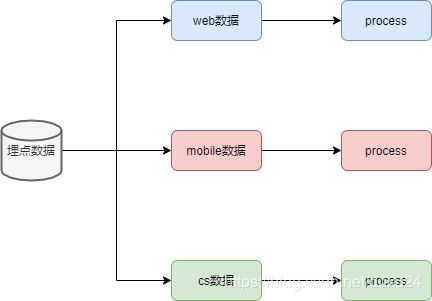Flink——Side Output侧输出流
主要内容:
- 结合应用场景,介绍Flink侧输出流的使用流程和原理
在处理数据的时候,有时候想对不同情况的数据进行不同的处理,那么就需要把数据流进行分流。可以在主数据流上产生出任意数量额外的侧输出流。
1 场景
某公司使用埋点组件收集到了埋点数据,并实时写入了Kafka。其中,埋点数据共分为三类:Web端埋点数据、移动端埋点数据和CS端埋点数据。现在需要从Kafka读取埋点数据,并分别对三端数据做不同的处理逻辑:
2 Side Output
当然使用 filter 对主数据流进行过滤,也能满足上述场景,但每次筛选过滤都要保留整个流,然后通过遍历整个流来获取相应的数据,显然很浪费性能。假如能够在一个流里面就进行多次输出就好了,恰好 Flink 的 Side Output 提供了这样的功能。Flink的Side Output侧输出流的作用在于将主数据分割成多个不同的侧输出流。侧输出结果流的数据类型不需要与主数据流的类型一致,不同侧输出流的类型也可以不同。
在上述场景中,可以使用Flink此功能:将Kafka的埋点数据进行分类,分为web端、mobile端和CS端三类,然后再对每类埋点数据进行相应的处理。
3 处理流程
3.1 定义OutputTag
在使用侧输出的时候需要先定义一个OutputTag,来标识 Side Output,代表这个 Tag 是要收集哪种类型的数据。这里定义了三个 OutputTag:
webTerminal:web端埋点数据mobileTerminal:移动端埋点数据csTerminal:CS端埋点数据
lazy val webTerminal: OutputTag[MdMsg] = new OutputTag[MdMsg]("Web端埋点数据")
lazy val mobileTerminal: OutputTag[MdMsg] = new OutputTag[MdMsg]("移动端埋点数据")
lazy val csTerminal: OutputTag[MdMsg] = new OutputTag[MdMsg]("CS端埋点数据")
3.2 使用特定的处理函数
要使用侧输出,在处理数据的时候除了要定义相应类型的OutputTag外,还要使用特定的函数,主要是有四个:
ProcessFunctionCoProcessFunctionProcessWindowFunctionProcessAllWindowFunction
该场景里选择使用ProcessFunction函数。该函数继承于RichFunction,使用时必须要重写processElement方法。自定义ProcessFunction函数:
class MdSplitProcessFunction extends ProcessFunction[MdMsg, MdMsg] {
override def processElement(value: MdMsg, ctx: ProcessFunction[MdMsg, MdMsg]#Context, out: Collector[MdMsg]): Unit = {
// web
if (value.mdType == "web") {
ctx.output(webTerminal, value)
// mobile
} else if (value.mdType == "mobile") {
ctx.output(mobileTerminal, value)
// cs
} else if (value.mdType == "cs") {
ctx.output(csTerminal, value)
// others
} else {
out.collect(value)
}
}
}
3.3 对每个侧输出流做处理
为每种类型的侧输出流添加处理逻辑,直接调用getSideOutput函数:(这里的处理逻辑进展示直接打印)
// Web端埋点数据流
outputStream.getSideOutput(webTerminal).print("web")
// Mobile端埋点数据流
outputStream.getSideOutput(mobileTerminal).print("mobile")
// CS端埋点数据流
outputStream.getSideOutput(csTerminal).print("cs")
4 代码
4.1 代码
package org.ourhome.streamapi
import org.apache.flink.streaming.api.TimeCharacteristic
import org.apache.flink.streaming.api.functions.ProcessFunction
import org.apache.flink.streaming.api.scala._
import org.apache.flink.util.Collector
/**
* @Author Do
* @Date 2020/5/3 20:35
*/
object SideOutputTest2 {
lazy val webTerminal: OutputTag[MdMsg] = new OutputTag[MdMsg]("Web端埋点数据")
lazy val mobileTerminal: OutputTag[MdMsg] = new OutputTag[MdMsg]("移动端埋点数据")
lazy val csTerminal: OutputTag[MdMsg] = new OutputTag[MdMsg]("CS端埋点数据")
def main(args: Array[String]): Unit = {
val env: StreamExecutionEnvironment = StreamExecutionEnvironment.getExecutionEnvironment
env.setStreamTimeCharacteristic(TimeCharacteristic.ProcessingTime)
env.setParallelism(1)
val socketData: DataStream[String] = env.socketTextStream("localhost", 9999)
socketData.print("input data")
val outputStream: DataStream[MdMsg] = socketData.map(line => {
val str: Array[String] = line.split(",")
MdMsg(str(0), str(1), str(2).toLong)
})
.process(new MdSplitProcessFunction)
// Web端埋点数据流处理逻辑
outputStream.getSideOutput(webTerminal).print("web")
// Mobile端埋点数据流处理逻辑
outputStream.getSideOutput(mobileTerminal).print("mobile")
// CS端埋点数据流处理逻辑
outputStream.getSideOutput(csTerminal).print("cs")
env.execute()
}
case class MdMsg(mdType:String, url:String, Time:Long)
class MdSplitProcessFunction extends ProcessFunction[MdMsg, MdMsg] {
override def processElement(value: MdMsg, ctx: ProcessFunction[MdMsg, MdMsg]#Context, out: Collector[MdMsg]): Unit = {
// web
if (value.mdType == "web") {
ctx.output(webTerminal, value)
// mobile
} else if (value.mdType == "mobile") {
ctx.output(mobileTerminal, value)
// cs
} else if (value.mdType == "cs") {
ctx.output(csTerminal, value)
// others
} else {
out.collect(value)
}
}
}
}
4.2 测试
输入1:
web,http://www.web1.com,1587787201000
mobile,http://www.mobile1.com,1587787202000
cs,http://www.cs1.com,1587787203000
输出1:
input data> web,http://www.web1.com,1587787201000
web> MdMsg(web,http://www.web1.com,1587787201000)
input data> mobile,http://www.mobile1.com,1587787202000
mobile> MdMsg(mobile,http://www.mobile1.com,1587787202000)
input data> cs,http://www.cs1.com,1587787203000
cs> MdMsg(cs,http://www.cs1.com,1587787203000)
可见:Flink将接收到的数据,分别分到了web埋点数据流、移动端埋点数据流和CS端埋点数据流中,并分别打印。
输入2:
other,http://www.other.com,1587787201000
输出2:
input data> other,http://www.other.com,1587787201000
可见:Flink将接收到的数据发到了常规数据流中,并打印。
